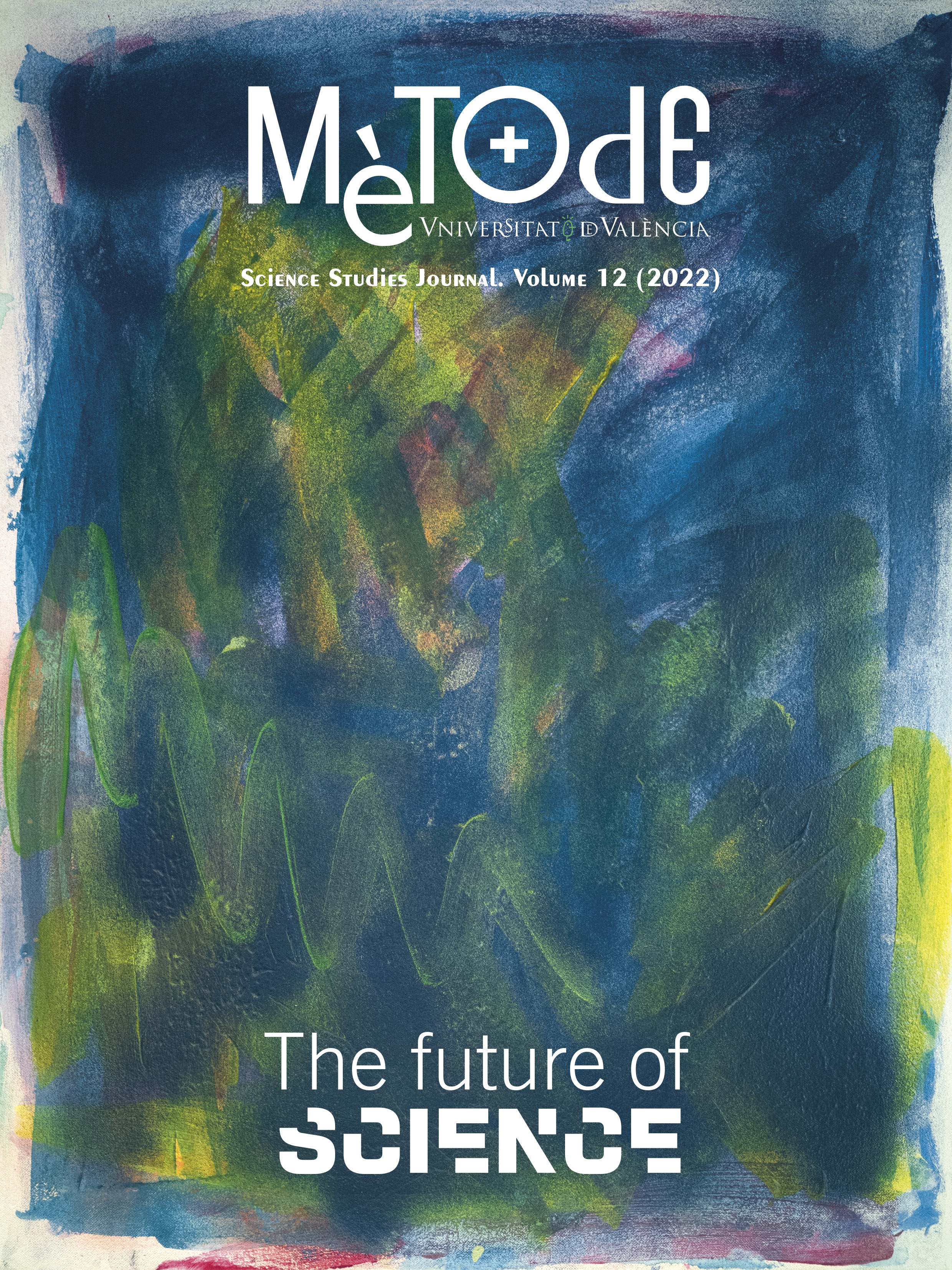La ciència del transhumanisme: Ja som a prop?
DOI:
https://doi.org/10.7203/metode.12.20710Paraules clau:
millorament, interfície humana-màquina, CRISPR, cíborg, edició genòmica Resum
Resum
L’objectiu del transhumanisme és utilitzar la ciència i la tecnologia per portar els éssers humans més enllà dels límits de la seua forma natural. Per primera vegada, els avanços científics recents han possibilitat intervencions genètiques relacionades amb l’evolució humana dirigida. Un altre tipus de desenvolupaments ens han donat innovacions electromecàniques, incloent-hi la miniaturització de components i millores en materials biocompatibles, i s’estan creant interfícies cervell-màquina (ICM) que potencien una dimensió cibernètica en la qual podríem controlar dispositius mecànics amb la ment. Aquest article repassa els avanços recents més importants, amb especial atenció a l’edició genòmica i els usos terapèutics de les ICM, així com altres usos d’aquestes tecnologies per al millorament humà.
 Descàrregues
Descàrregues
 Referències
Referències
Begley, S. (2017, August 10). Birth of CRISPR’d pigs advances hopes for turning swine into organ donors. STAT. https://www.statnews.com/2017/08/10/crispr-pigs-organ-transplant
Brooks, R. (2017). The seven deadly sins of AI predictions. MIT Technology Review, 120(6), 79–86. https://www.technologyreview.com/2017/10/06/241837/the-seven-deadly-sins-of-ai-predictions
Collinger, J. L., Wodlinger, B., Downey, J. E., Wang, W., Tyler-Kabara, E. C., Weber, D. J., McMorland, A. J. C., Velliste, M., Boninger, M. L., & Schwartz, A. B. (2013). High-performance neuroprosthetic control by an individual with tetraplegia. The Lancet, 381(9866), 557–564. https://doi.org/10.1016/S0140-6736(12)61816-9
Corbyn, Z. (2019, September 22). Are brain implants the future of thinking? The Guardian. https://www.theguardian.com/science/2019/sep/22/brain-computer-interface-implants-neuralink-braingate-elon-musk
Flesher, S. N., Collinger, J. L., Foldes, S. T., Weiss, J. M., Downey, J. E., Tyler-Kabara, E. C., Bensmaia, S. J., Schwartz, A. B., Boninger, M. L., & Gaunt, R. A. (2016). Intracortical microstimulation of human somatosensory cortex. Science Translational Medicine, 8(361), 361ra141. https://doi.org/10.1126/scitranslmed.aaf8083
Gaj, T., Gersbach, C. A., & Barbas III, C. F. (2013). ZFN, TALEN, and CRISPR/Cas-based methods for genome engineering. Trends in Biotechnology, 31(7), 397–405. https://doi.org/10.1016/j.tibtech.2013.04.004
Giger, J. C., Piçarra, N., Alves‐Oliveira, P., Oliveira, R., & Arriaga, P. (2019). Humanization of robots: Is it really such a good idea? Human Behavior and Emerging Technologies, 1(2), 111–123. https://doi.org/10.1002/hbe2.147
Lebedev, M. A., Opris, I., & Casanova, M. F. (2018). Augmentation of brain function: Facts, fiction and controversy. Frontiers in Systems Neuroscience, 12, 45. https://doi.org/10.3389/fnsys.2018.00045
Platt, R. J. (2019). CRISPR tool enables precise genome editing. Nature, 576, 48–49. https://doi.org/10.1038/d41586-019-03392-9
Polikov, V. S., Tresco, P. A., & Reichert, W. M. (2005). Response of brain tissue to chronically implanted neural electrodes. Journal of Neuroscience Methods, 148(1), 1–18. https://doi.org/10.1016/j.jneumeth.2005.08.015
Rauti, R., Musto, M., Bosi, S., Prato, M. & Ballerini, L. (2019). Properties and behavior of carbon nanomaterials when interfacing neuronal cells: How far have we come? Carbon, 143, 430–446. https://doi.org/10.1016/j.carbon.2018.11.026
Regalado, A. (2019, December 30). He Jiankui faces three years in prison for CRISPR babies. MIT Technology Review. https://www.technologyreview.com/2019/12/30/131061/he-jiankui-sentenced-to-three-years-in-prison-for-crispr-babies
Roelfsema, R., Denys, D., & Klink, P. C. (2018). Mind reading and writing: The future of neurotechnology. Trends in Cognitive Sciences, 22(7), 598–610. https://doi.org/10.1016/j.tics.2018.04.001
Salas, M. A., Bashford, L., Kellis, S., Jafari, M., Jo, H. C., Kramer, D., Shanfield, K., Pejsa, K., Lee, B., Liu, C. Y., & Andersen, R. A. (2018). Proprioceptive and cutaneous sensations in humans elicited by intracortical microstimulation. eLife, 7, e32904. https://doi.org/10.7554/eLife.32904
Shook, J. R., & Giordano, J. (2016). Neuroethics beyond normal: Performance enablement and self-transformative technologies. Cambridge Quarterly of Healthcare Ethics, 25(1), 121–140. https://doi.org/10.1017/S0963180115000377
Tirosh-Samuelson, H. (2018). In pursuit of perfection: The misguided transhumanist vision. Theology and Science, 16(2), 200–222. https://doi.org/10.1080/14746700.2018.1463659
Waldert, S. (2016). Invasive vs. non-invasive neuronal signals for brain-machine interfaces: Will one prevail? Frontiers in Neuroscience, 10, 295. https://doi.org/10.3389/fnins.2016.00295
Wang, T., Wei, J. J., Sabatini, D. M., & Lander, E. S. (2014). Genetic screens in human cells using the CRISPR-Cas9 system. Science, 343(6166), 80–84. https://doi.org/10.1126/science.1246981
Yazdi, P. (2020, September 22). 13 effects of transcranial direct current stimulation (tDCS). SelfHacked. https://selfhacked.com/blog/tdcs-benefits
Descàrregues
Arxius addicionals
Publicades
Com citar
-
Resum1495
-
(Español)6
-
PDF 921
Número
Secció
Llicència
![]()
Tots els documents inclosos en OJS són d'accés lliure i propietat dels seus autors.
Els autors que publiquen en aquesta revista estan d'acord amb els següents termes:
- Els autors conserven els drets d'autor i garanteixen a la revista el dret a la primera publicació del treball, llicenciat baix una llicència de Reconeixement-NoComercial-SenseObraDerivada 4.0 Internacional de Creative Commons, que permet a altres compartir el treball amb un reconeixement de l'autoria del treball i citant la publicació inicial en aquesta revista.
- Es permet i s'anima els autors a difondre la versió definitiva dels seus treballs electrònicament a través de pàgines personals i institucionals (repositoris institucionals, pàgines web personals o perfils a xarxes professionals o acadèmiques) una vegada publicat el treball.





